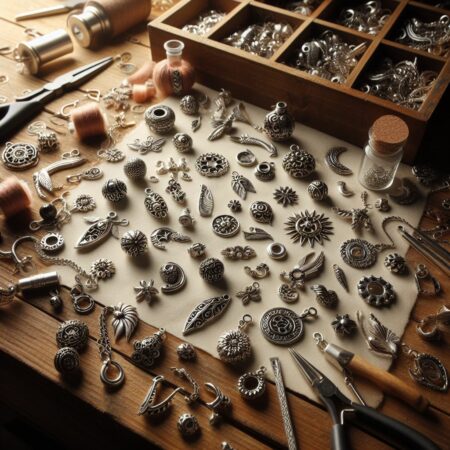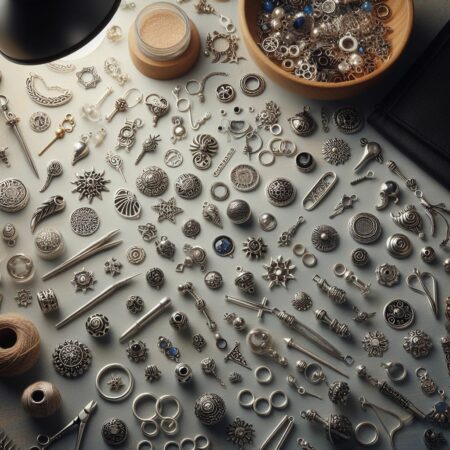Jewelry beads are among the oldest human creations around. They’ve been around since ancient times. Yet, surprisingly, even the Ancient Egyptians had a profoundly modern way of creating metal beads, even experimenting with soldering to create silver beads for jewelry.
Today we will look at various jewelry beads that you can use for crafting virtually anything from charm bracelets, beaded bracelets, metal bead necklaces, and anything that needs beads. Beads are not complicated, but if you’re developing techniques or acquainting yourself with the different materials you can use for crafting, this list would be a good introduction.
Seed Beads
Seed beads, also called rocailles, are tiny, round beads that come in many sizes. The term “seed bead” can also refer to any small bead. Seed beads, typically spherical, are the most popular bead used for bead weaving, jewelry making, and crafting. Seed beads can be strung alone or used to separate more elaborate beads.
Copper Beads
Next to gold and silver, Copper is a common choice for jewelry creation. It’s not just for jewelry anymore; Copper is used in money, antique tools, the weapons industry, and much more. Copper has its incentive hue, making it one of the four metallic elements that exhibit. Copper is used to creating brass and bronze, two of the most significant and commercially successful metal alloys.
Gold-filled jewelry, in contrast to solid gold jewelry, consists of a layer of gold bonded to a base metal like sterling silver or Copper. Gold-filled beads may be more affordable than solid gold, but it lasts much longer and retains its luster and shine even after years of daily wear.
Gold’s softness is a significant drawback despite all its other advantages. As a result, it will wear out quickly.
However, when gold is combined with other metals, an alloy is formed that is superior in strength and durability, making it a better choice for jewelry. Jewelers make certain jewelry pieces from pure gold, but most people avoid wearing them because they are easily damaged and show signs of wear.
Half the typical weight of a piece of gold-filled jewelry can be achieved by using gold-filled jewelry that is only 1/40th as thick. Hence the name “rolled gold plate.” According to the Gem Society, quality is the main distinction between gold fill and gold plate. Gold plating is thinner and more cost-effective than gold foils. However, since it only has a few thousandths of an inch of thickness at most, gold plating quickly loses its luster and starts to flake off.
Sterling Silver Beads
Gold and silver have both been more valuable at different points in history. Silver has been used as currency and in making sterling silver beads for centuries, and it now has a wide variety of other applications. Photography, batteries, auto glass defoggers, and magnetic strips are a few examples of what we use today.
Silver is one of the most widely used jewelry metals for various reasons. Its shine is the first thing people notice about it. Silver is more affordable and more readily available than gold or platinum.
However, silver is more difficult to work than gold because it conducts heat well. Therefore, soldering on silver is an ordinary skill for beginning jewelers to acquire. Once they master soldering on this highly conductive metal, they will have a much easier time managing the heat on gold.
There are drawbacks to using this noble metal. Silver, in particular, loses its luster over time. Tarnish refers to the layer of corrosion that develops on the surface of certain metals, such as silver, due to chemical reactions. For example, hydrogen sulfide is a critical ingredient in the chemical process that oxidizes silver. Because this compound exists in the air, silverware left out in the open will inevitably tarnish.
Tarnish on silver can be kept to a minimum by keeping it in a pouch or other sealed container when not in use. Time spent removing tarnish from silverware will be reduced. There’s no denying that silver needs more TLC than other precious metals when worn as jewelry. However, some methods are available, from store-bought silver polish to homemade solutions. Be patient with your silver jewelry; tarnish isn’t a deal breaker.
Glass Beads
Glass beads can be needle woven like a fabric band, strung in single strands, or sewn to objects using a variety of stitches. Necklaces and bracelets made from beads strung on a single thread can be as simple or intricate as the wearer desires. Additionally, beads can be sewn individually to create elaborate designs. However, the beads must first be strung in strands to make a needlewomen bead band.
In this context, “backing material” refers to the garment, accessory, or other items to which the beads have been affixed. Cotton and linen thread, as well as sinew, are common threading materials. Beads of glass are formed when silica and other minerals are heated to a high enough temperature to melt and form a thick, viscous liquid. As the liquid cools, it solidifies into the desired shape.
To achieve the desired hue in colored glass, the formula is tweaked by adding or removing minerals and other substances. Molten beads can be rolled in warm, crushed colored glass and minerals during the manufacturing process to add color. A glass bead’s inner core may have been colored, and this coloring may flake or peel off over time.
You can find glass beads in every imaginable size and form. To make beads, molten glass is typically wound along a long iron rod. While the bead is still semi-pliable, it can be molded into various forms. By applying pressure to the hot bead while it is on a flat surface, it is possible to create the square and oval beads. More complex shapes are made using molds.
Lampwork Beads
Lampwork jewelry beads, made of glass and crafted by hand, are works of art. To create them, a torch is used to melt glass. Lampwork beads are created by melting together different colored glass to create the intricate designs that decorate their surfaces. Beads and other forms can be created using the technique known as “Lampwork,” which involves melting and shaping glass in a flame. Historically, lampwork was performed using a small oil-burning lamp.
Lampwork glass jewelry is typically made from two types of glass: a soft glass containing soda and lime and a stiff glass called borosilicate. Although soft glass is more user-friendly due to its lower melting point, it is also more brittle than its rigid counterpart.
A torch that uses pure oxygen to generate a hotter flame is necessary for working with borosilicate; this flame is then used to color the chemicals in the glass. No matter the type of glass, once it has been melted and shaped into the final product, it must be annealed to ensure complete durability. To achieve this, a kiln is used to maintain a high temperature in the glass. Then the temperature is gradually reduced to prevent shock and crack, making the finished product durable and long-lasting.
Crystal Beads
Crystal jewelry beads are high-shine crystal beads crafted from leaded glass. Typically, they have a faceted cut that increases their sparkle. Crystals made in the Czech Republic are not as well-known as those made by Swarovski but are just as high-quality at a lower cost. Crystal beads are often used for elaborate jewelry, such as wedding dresses and tiaras. JewelIn addition, jeweler’s clear crystals, such as Crystals in the shape of flatbacks, chatons, and rivolis, are also manufactured by Swarovski.
Crystals that have been cut with a flat back are called flatbacks. Alternatively, you can get a hotfix, iron-on flatbacks for clothing. Crystal beads, known as chatons, have a pointed back and foiling to increase their reflective qualities. Crystals in the Rivoli family are typically round and have rounded corners on both the front and back. Because they lack a threading hole, they are typically beveled with seed beads or glued into a setting.
Wooden Beads
Wooden jewelry beads have deep spiritual significance and have been used for centuries. The best ones are made from natural wood sourced from all over the world, such as Balsa, Olive, and Sandalwood, and come in an array of colors and styles to meet any requirement, whether it be for religious or spiritual purposes, creative endeavors, or even just personal gratification.
Curious as to what these might represent or symbolize. This is debatable, as many religions and cultures make different uses for these variants, each with hidden significance.
Since they are porous, options can be stained or painted to any desired shade, and they come in a wide range of shades, from very light to dark. Saturating and darkening wooden these with fragrant essential oils can also add therapeutic elements to meditation practice. For example, Rosewood encourages love, empathy, and a sense of spirituality because of its unique energy. Are they trying to become a kinder, gentler person? Rosewood can be used as an aid in daily prayer and meditation. What’s more, the colors affect the vibe during your routine.
Bracelets made of wooden beads convey an air of freewheeling Bohemianism. They’re a great way to add a touch of authenticity and universal appeal to any ensemble, but they can also have significant symbolic significance. Wood bead bracelets are historically significant and eternally fashionable because of their understated elegance and minimalist design.
Bracelets strung with wooden beads are commonly exchanged among followers of New Age religions because of the widespread belief that they symbolize originality and freedom.
Bead bracelets, especially those with tassels or pom-poms, are commonly worn and handled as a means of concentration during recitations, chants, and mantras in the contexts of yoga, meditation, and other spiritual practices. This physical practice has been shown to enhance focus, calm the mind, and strengthen bonds with others. The addition of a cross to a prayer bead bracelet, for example, carries additional significance. Since lucky charms are worn by both sexes, a bracelet seems like the perfect accessory. To make them suitable for a wider range of recipients, the band can be expanded. Having a wooden bracelet on your wrist means you always have something you can use for your daily mantra, prayer, or meditation practice.
Ceramic Beads
Zirconium oxide ceramic, used to make ceramic jewelry beads, is known for its extreme strength and durability. Due to their lack of iron content, they can be used with both aluminum and stainless steel. Because of their spherical shape, ceramic beads can be used for gentle cleaning and to create aesthetically pleasing finishes. This blasting medium outlasts glass beads by a wide margin. There is no higher-quality blasting medium than ceramic beads.
Pony Beads
The pony jewelry beads of today are colorful and made of plastic. They’re considered beginner beads because they’re lightweight and they’re typically used to create more youthful designs. The history of the name is interesting, too.
Guns, iron tools, colored fabrics and glass beads, among other European trade goods, had already been traveling the Plains on active trade routes by the time Europeans arrived in the mid-1800s.
Most of the new traded beads were manufactured from glass, which is something that had never been used by the indigenous peoples. Stone, Copper, shell, and bone were frequently replaced by these glass beads.
Because of their small size and portability, beads played a crucial role in early commercial exchanges. Beads commonly known as “pony” beads first appeared in the early 1800s, and they got their name from the fact that they were transported to markets by traders using pony pack trains. In 1840, as better manufacturing systems and techniques were standardized in Europe, the more colorful “seed beads” were traded in bulk.






